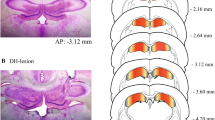Abstract
Acute and chronic intact cat preparations were made with recording electrodes located in the dorsal hippocampus and cerebral cortex, stimulating electrodes in the mesencephalic reticular formation, and an “Injectrode” in the posterior hypothalamus through which both electrical and pharmacological stimulation could be applied. In all preparations 12–200 μg hemicholinium (HC-3), administered through the “Injectrode”, suppressed the hippocampal theta rhythm previously elicited by electrical stimulations of either the reticular formation or the posterior hypothalamus. The latency for this effect ranged from 90 min to 3 hours. Reticular-induced desynchronization of the cortical EEG disappeared 2–5 hours after HC-3 administration. Reversal of the HC-3 effect on the hippocampal theta rhythm was seen shortly after administration of carbachol, bethanechol and pilocarpine. No consistent behavioral effects accompanied these changes in EEG. These findings are discussed in light of the hypothesis that HC-3 exerts a post-synaptic action in the CNS, although a pre-synaptic effect through diffusion of the injected HC-3 to a distant site cannot be ruled out with certainty.
Similar content being viewed by others
References
Baker, W. W., Benedict, F.: Analysis of local discharges induced by intrahippocampal microinjection of carbachol or diisopropylfluorophosphate (DFP). Int. J. Neuropharmacol. 7, 135–147 (1968).
Baxter, B. L.: Induction of both emotional behavior and a novel form of REM sleep by chemical stimulation applied to cat mesencephalon. Exp. Neurol. 23, 220–229 (1969).
Bertolini, A., Greggia, A., Ferrari, W.: Atropine-like properties of hemicholinium-3. Life Sci. 6, 537–543 (1967).
Carlton, P. L.: Cholinergic mechanisms in control of behavior by the brain. Psychol. Rev. 70, 19–39 (1964).
Dren, A. T., Domino, E. F.: Effects of hemicholinium (HC-3) on EEG activation and brain acetylcholine in the dog. J. Pharmacol. exp. Ther. 161, 141–154 (1968).
Frazier, D. T.: Effect of hemicholinium no. 3 on amphibian nerve. Exp. Neurol. 20, 245–254 (1968).
—, Narahashi, T., Moore, J. W.: Hemicholinium-3: non-cholinergic effects on squid axons. Science 163, 820–821 (1969).
Herz, A.: Excitation and inhibition of cholinoceptive brain structures and its relationship to pharmacologically induced behavior changes. Int. J. Neuropharmacol. 2, 205–216 (1963).
Jasper, H. H., Ajmone-Marsan, C. A.: A stereotaxic atlas of the diencephalon of the cat. National Research Council of Canada, Ottawa, 1954.
Longo, V. G.: Behavioral and electroencephalographic effects of atropine and related compounds. Pharmacol. Rev. 18, 965–996 (1966).
Parkes, M. W.: An examination of central actions characteristic of scopolamine: comparison of central and peripheral activity in scopolamine, atropine and some basic esters. Psychopharmacologia (Berl.) 7, 1–19 (1965).
Schueler, F. W.: The mechanism of action of the hemicholiniums. Int. Rev. Neurobiol. 2, 77–97 (1960).
Stumpf, C.: Drug action on the electrical activity of the hippocampus. Int. Rev. Neurobiol. 8, 77–138 (1965).
Torii, S., Wikler, A.: Effect of atropine on electrical activity of hippocampus and cerebral cortex in cat. Psychopharmacologia (Berl.) 9, 189–204 (1966).
Votava, Z., Benešová, O., Bohdanecký, Z., Grofová, O.: Influence of atropine, scopolamine and benactyzine on the physostigmine arousal reaction in rabbits. In: Progr. Brain Research, Vol. 28, Anticholinergic Drugs and Brain Functions in Animals and Man, p. 40. Ed. P. B. Bradley and M. Fink. Amsterdam: Elsevier 1968.
Author information
Authors and Affiliations
Additional information
This research was supported by Public Health Service General Research Support Grant No. FR05374.
Rights and permissions
About this article
Cite this article
Friedman, M.J., Wikler, A. The effect of intrahypothalamic microinjection of hemicholinium (HC-3) on the hippocampal theta rhythm of cats. Psychopharmacologia 17, 345–353 (1970). https://doi.org/10.1007/BF00404240
Received:
Revised:
Issue Date:
DOI: https://doi.org/10.1007/BF00404240



